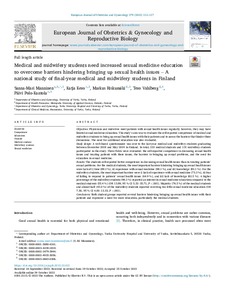Medical and midwifery students need increased sexual medicine education to overcome barriers hindering bringing up sexual health issues - A national study of final-year medical and midwifery students in Finland
Manninen Sanna-Mari; Kero Katja; Riskumäki Markus; Vahlberg Tero; Polo-Kantola Päivi
https://urn.fi/URN:NBN:fi-fe2022112968061
Tiivistelmä
Objectives: Physicians and midwives meet patients with sexual health issues regularly; however, they may have limited sexual medicine education. The study's aim was to evaluate the self-reported competence of medical and midwifery students to bring up sexual health issues with their patients and to assess the barriers that hinder these discussions. The need for additional education was also evaluated.
Study design: A web-based questionnaire was sent to the last-year medical and midwifery students graduating between December 2018 and May 2019 in Finland. In total, 233 medical students and 131 midwifery students participated in the study. Three fields were evaluated: the self-reported competence in discussing sexual health issues and treating patients with these issues, the barriers to bringing up sexual problems, and the need for education in sexual medicine.
Results: The students self-reported better competence in discussing sexual health issues than in treating patients' sexual problems. For the medical students, the most important barriers hindering bringing up sexual health issues were lack of i) time (89.2 %), ii) experience with sexual medicine (88.1 %), and iii) knowledge (82.1 %). For the midwifery students, the most important barriers were i) lack of experience with sexual medicine (73.3 %), ii) fear of failing to respond to patients' sexual health issues (64.9 %), and iii) lack of knowledge (62.5 %). A higher percentage of the midwifery students (96.2 %) reported an interest in sexual medicine education compared to the medical students (55.4 %) (OR 13.89, 95 % CI 5.32-35.71, P <.001). Majority (76.5 %) of the medical students and almost half (45.0 %) of the midwifery students reported receiving too little sexual medicine education (OR 7.30, 95 % CI 4.00-13.33, P <.001).
Conclusions: Both student groups reported several barriers hindering bringing up sexual health issues with their patients and expressed a need for more education, particularly the medical students.
Kokoelmat
- Rinnakkaistallenteet [27094]
